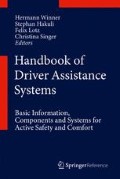Abstract
In this article, the development of the maneuver-based vehicle guidance concept Conduct-by-Wire is described. After a brief introduction, the function allocation between driver and vehicle is presented in detail. A promising approach is the separation of decision making and execution. Therefore, while driving with Conduct-by-Wire, the driver passes maneuver commands to the vehicle which are then translated into driving functions. In this article, the development and verification of both, maneuvers and driving functions, are described. The article closes with the development and evaluation of an interaction concept for maneuver inputs and an outlook on future work.
Contribution to this publication was developed during research assistant work at the Institute of Automotive Engineering at the Technische Universität Darmstadt.
Access this chapter
Tax calculation will be finalised at checkout
Purchases are for personal use only
References
Chapanis A (1965) On the allocation of functions between men and machines. Occup Psychol 39:1–11
Donges E (1982) Aspekte der aktiven Sicherheit bei der Führung von Personenkraftwagen (Aspects of active safety while driving passenger cars). Automobilindustrie 27(2):183–190
Edwards E, Lees FP (1973) Man and computer in process control. Institution of Chemical Engineers, London
Fitts PM (1951) Human engineering for an effective air navigation and traffic control system. National Research Council, Washington, DC
Franz B (2014) Entwicklung und Evaluation eines Interaktionskonzepts zur manöverbasierten Führung von Fahrzeugen (Development and evaluation of an interaction concept for maneuver based vehicle guidance). Technische Universität Darmstadt, Darmstadt
Franz B, Kauer M, Schreiber M, Blanke A, Distler S, Bruder R, Geyer S (2011) Maneuver-based driving today and in the future – development of a new human-machine interface for conduct-by-wire. In VDI-Bericht. Fahrer, Fahrerunterstützung und Bedienbarkeit, vol 2134. Braunschweig
Franz B, Kauer M, Blanke A, Schreiber M, Bruder R, Geyer S (2012a) Comparison of two human-machine-interfaces for cooperative maneuver-based driving. Work J Prev Assess Rehabil 41(1):4192–4199
Franz B, Kauer M, Bruder R, Geyer S (2012b) pieDrive – a new driver-vehicle interaction concept for maneuver-based driving. In: Toledo-Moreo R, Bergasa LM, Sotelo MÁ (eds) Proceedings of the 2012 international IEEE intelligent vehicles symposium workshops (W2: workshop on human factors in intelligent vehicles), Alcala de Henares (Spain)
Geyer S (2013) Entwicklung und Evaluierung eines kooperativen Interaktionskonzepts an Entscheidungspunkten für die teilautomatisierte, manöverbasierte Fahrzeugführung (Development and evaluation of a cooperative interaction concept on decision points for semi automated maneuver based vehicle guidance). Fortschritt-Berichte VDI Reihe 12, vol 770. Düsseldorf
Geyer S, Hakuli S, Winner H, Franz B, Kauer M (2011) Development of a cooperative system behavior for a highly automated vehicle guidance concept based on the conduct-by-wire principle. In: Intelligent vehicles symposium (IV), 2011 IEEE. IEEE, BadenBaden, pp 411–416
Hakuli S, Kluin M, Geyer S, Winner H (2010) Development and validation of manoeuvre-based driver assistance functions for conduct-by-wire with IPG CarMaker. In: Proceedings of the FISITA 2010 world automotive congress, 30 May–4 June 2010. FISITA, Budapest
Kauer M, Schreiber M, Bruder R (2010) How to conduct a car? A design example for maneuver based driver-vehicle interaction. In: 2010 I.E. intelligent vehicles symposium (IV). IEEE, San Diego, CA, pp 1214–1221
Kraiss K, Schmidtke H (2002) Funktionsteilung Mensch-Maschine (Function distribution human-machine). In: Bundesamt für Wehrtechnik und Beschaffung (ed) Handbuch der Ergonomie: Erg.-Lfg. 7. Carl Hanser, München
Luczak H (1975) Untersuchungen informatorischer Belastung und Beanspruchung des Menschen (Investigations of informational stress and strains of humans), Fortschrittberichte der VDI-Zeitschriften. VDI-Verlag, Düsseldorf
Parasuraman R, Sheridan T, Wickens C (2000) A model for types and levels of human interaction with automation. IEEE Trans Syst Man Cybern A Syst Hum 30(3):286–297
Price HE (1985) The allocation of functions in systems. Hum Factors J Hum Factors Ergon Soc 27(1):33–45. doi:10.1177/001872088502700104
Schreiber M (2012) Konzeptionierung und Evaluierung eines Ansatzes zu einer manöverbasierten Fahrzeugführung im Nutzungskontext Autobahnfahrten (Concept and evaluation of an approach for a maneuver based vehicle guidance in the context of motorway driving). TU Darmstadt
Schreiber M, Kauer M, Bruder R (2009) Conduct by wire – maneuver catalog for semi-autonomous vehicle guidance. In: Intelligent vehicles symposium, 2009 IEEE: intelligent vehicles symposium. IEEE, Xi’an, China, pp 1279–1284
Schreiber M, Kauer M, Schlesinger D, Hakuli S, Bruder R (2010) Verification of a maneuver catalog for a maneuver-based vehicle guidance system. In: Systems man and cybernetics (SMC), Istanbul, pp 3683–3689
Sheridan TB (2006) Supervisory control. In: Handbook of human factors and ergonomics. Wiley, Hoboken, pp 1025–1052
Winner H, Hakuli S (2006) Conduct-by-wire-following a new paradigm for driving into the future. In: Proceedings of FISITA world automotive congress, Yokohama
Winner H, Heuss O (2005) X-by-Wire Betätigungselemente-Überblick und Ausblick (X-by-Wire actuating elements – overview and outlook). In: Darmstädter Kolloquium Mensch und Fahrzeug. Cockpits für Straßenfahrzeuge der Zukunft, pp 79–115
Author information
Authors and Affiliations
Corresponding author
Editor information
Editors and Affiliations
Rights and permissions
Copyright information
© 2016 Springer International Publishing Switzerland
About this entry
Cite this entry
Franz, B., Kauer, M., Geyer, S., Hakuli, S. (2016). Conduct-by-Wire. In: Winner, H., Hakuli, S., Lotz, F., Singer, C. (eds) Handbook of Driver Assistance Systems. Springer, Cham. https://doi.org/10.1007/978-3-319-12352-3_59
Download citation
DOI: https://doi.org/10.1007/978-3-319-12352-3_59
Published:
Publisher Name: Springer, Cham
Print ISBN: 978-3-319-12351-6
Online ISBN: 978-3-319-12352-3
eBook Packages: EngineeringReference Module Computer Science and Engineering

